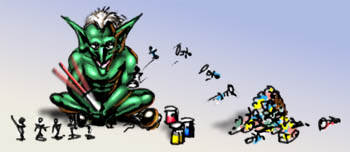|
|
©1999-2003. All rights reserved. |
Painting Speed Tips

Painting OrderApplying the paint neatly to areas obviously takes more time than slapping it on, so you should organise the painting process to allow you to be as careless as possible. Subsequent coats of paint and shading can be used to cover up previous slips. Don't fuss about making the base coat perfect because the only one that really matters is the final coat. While shading the base colours, you will have the opportunity to conceal minor slips. Messier processes such as drybrushing and shading should generally be done first. Sometimes it is easier to fully shade one area before base-coating the adjacent areas. This way you don't have to worry about paint getting in the wrong place, and you can really let fly with the brush. Finally areas which are harder to get at should be done before the more exposed ones, for example do skin before clothing. This minimises the chance of getting paint in the wrong place and then having to rectify it. Big brushesOne of the main advantages of using a decent sized brush rather than scratching about with an '0000' is speed. Big brushes cover areas quicker and also carry more paint which means less trips to the palette. A good brush still comes to a sharp point, so getting the edges neat shouldn't be a problem. Batches of colourThere can be an economy of scale by doing the same thing to a lot of figures in one go, although this has limitations because of the speed at which acrylic dries. It is only possible to cover a limited area with a single batch of mixed paint, however, shading a number of small items with the same colour at once is a definite time saving. Processes such as drybrushing, and basecoating with an unmixed colour, can be used on large numbers of figures in one go because there isn't the problem of paint drying on the palette. Basing is another area where doing really large quantities saves time. |

©2001. All rights reserved.
| |
